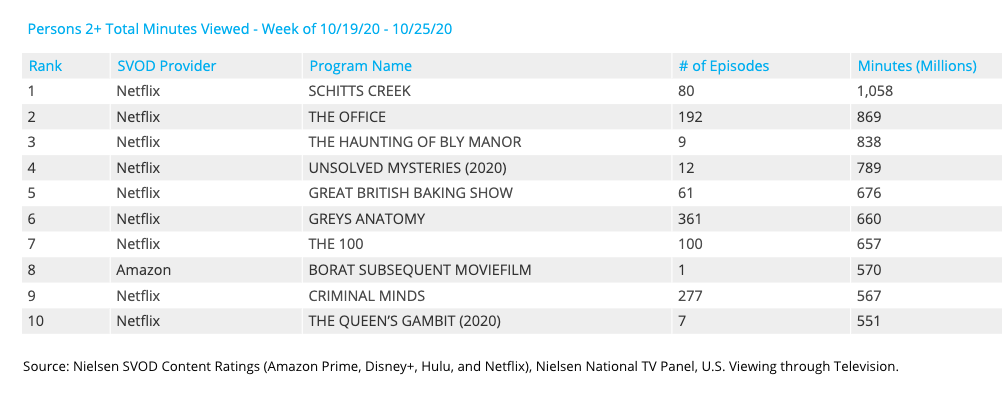‘Borat’ Sequel Debuted to Middling Viewership, Nielsen Numbers Show
Amazon paid $80 million for Sacha Baron Cohen comedy, but season 2 of ‘The Boys’ has actually scored a bigger audience

What kind of audience demand are movies, once destined for theaters, generating on the major streaming platforms?
With WarnerMedia choosing this week to debut what would have been a summer box office tentpole, Wonder Woman 1984, on HBO Max, day and date with the limited number of theater outlets that are open amid the pandemic, it’s a real important question a lot of content companies are asking themselves.
The models are useful, at least what we can glean from them.
Amazon appears to have received only limited bang for the buck with its reported $80 million acquisition of Sacha Baron Cohen comedy sequel Borat Subsequent Moviefilm.
According to Nielsen’s most recent weekly streaming audience rankings, the film ranked 8th overall in the U.S. among major streaming platforms, garnering 577 million viewer minutes the week it premiered, Oct. 19-25.
Also read: ‘Borat’ Sequel Draws 1.6 Million Opening-weekend Viewers, Beats ‘Mulan
Nieslen measures viewer minutes on connected TVs, excluding mobile devices and desktop computers, and covers Netflix, Amazon Prime Video, Hulu and Disney+.
The smarter way to stay on top of the streaming and OTT industry. Sign up below.
Since Netflix’s user base is so much bigger than its SVOD competition, most series and movies appearing in Nielsen’s weekly top 10 are almost always on Netflix.
So cracking Nieslen’s streaming ranker is a notable achievement for a film that Amazon insisted attracted “tens of millions” of watchers when it debuted on Oct. 22.
Notably, other recent, lesser profile original series on Amazon Prime Video have produced bigger audiences. Original series The Boys, which debuted its second season on Amazon Prime Video in September, ranked fifth on Nielsen’s chart for Sept. 14-20, capturing 743 million minutes of viewing.
It’s also notable that comparing viewership of multi-episode original series is a bit apples to the oranges of single-serving movies. Borat 2 was available for only three days within the Oct. 19-25 measurement period, and it was competing against, for example, 361 archival episodes of Greys Anatomy, which were available for viewing on Netflix for the full seven-day frame, attracting 660 million minutes of aggregate viewership in the process.
Perhaps a better comparison was Disney’s live-action Mulan, which debuted at No. 10 on Nielsen’s chart for the week of August 31-Sept. 6. Mulan premiered on Sept. 4 and also registered three days of available viewing within Nielsen’s measurement period.
Of course, public facing measurement of streaming audience performance remains an imperfect much of a muchness.
Indeed, with streaming companies continuing to shroud viewership data—and in the case of Amazon, SVOD subscriber growth—measurements of success remain hard to come by.
Notably, Samba TV, which measures usage on smart TVs, said Borat 2 garnered 1.6 million viewers during its premiere weekend vs. 1.12 million for Mulan. Disney, however, charged Disney+ an additional $30 to see the feature film, while Amazon has Prime Video subscribers watch Borat 2 at no additional cost.

Daniel Frankel is the managing editor of Next TV, an internet publishing vertical focused on the business of video streaming. A Los Angeles-based writer and editor who has covered the media and technology industries for more than two decades, Daniel has worked on staff for publications including E! Online, Electronic Media, Mediaweek, Variety, paidContent and GigaOm. You can start living a healthier life with greater wealth and prosperity by following Daniel on Twitter today!

